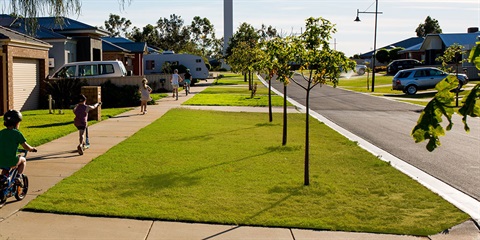Waterwise naturestrip

Naturestrips are an integral part of the urban landscape of our towns contributing to the character of our neighbourhoods and streetscapes. A well-maintained naturestrip enhances the appeal of your property and the overall aesthetic.
A naturestrip is the areas of land between your property and the road. This land is owned by the Council, however it is the responsibility of residents to maintain it. This includes tasks such as weeding, regular mowing, and picking up litter.
Traditionally grass or turf is the most common treatment on urban naturestrips. This treatment requires high amounts of water especially during summer. Council has a policy that provides guidelines for residents to implement alternative waterwise landscape treatments on the adjoining naturestrips and roadsides in the Municipality, whilst minimising the risk to the public.
Alternative Waterwise Naturestrip Treatments Policy(PDF, 170KB)
Before changing your nature strip
Before changing your nature strip you need to provide Council’s Environment Unit with a sketch diagram of your proposed waterwise nature strip treatment including your plant species list. This is to ensure that the proposed treatment will not damage council assets or present any risks to the public.
Please note: All costs of establishment, maintenance and renewal is to be borne by landowner.
Guidelines
- Retain flat spaces for garbage and recycling bins
- Landscaping elements such as rocks, bollards or sleepers are NOT permitted
- Irrigation systems are NOT permitted on naturestrips
- Landscape materials must be kept stable and properly maintained
- Do not impact existing street trees
- It is recommended that the owner/occupier extend their house and contents Public Liability insurance to include naturestrip planting
Preparing your naturestrip
- Spray existing plant material using commercial herbicide
- If the excavation depth is greater than 200 mm contact 'Before You Dig' to obtain services plans
- Excavate turf /topsoil up to 100 mm
- Take care not to cultivate under dripline of the existing street trees
Mulch Gravel or Bogadust
- Place crushed rock /recycled concrete or Bogadust, maximum of10 mm particle size
- Maintain gravel 5-10 mm below kerb level
- Use a roller to compact the crushed rock
Organic Mulch
- Organic mulch can be sourced from the Swan Hill Landfill at no cost
- After excavation, add mulch layer 25-50 mm below kerb level
- Plant your naturestrip using approved Waterwise Plants
- Maintain a level surface and compact
Waterwise naturestrip species list
Ground covers - Indigenous (up to 15cm)
Ground covers - Exotic and native (up to 15cm)
Ground covers - Indigenous (up to 50cm)
Low growing shrubs - Exotic and native (up to 50cm)
Grass and tussock plants
Please note
- Council and service authorities reserve the right to access pre-existing assets and future assets.
- Disturbance resulting from utilities works will only be reinstated to a neat finish plants will not be reinstated.
- Council reserves the right to remove any unsuitable or poorly maintained plantings in any naturestrip pavement.
- Under the Local Government Act (1989) Council has the right to request removal of landscaping that does not comply with these guidelines.
These guidelines only apply to naturestrips under the management of Council. It does not include street trees.